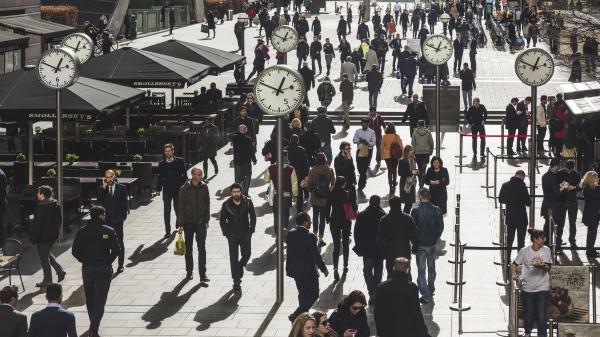What Is Daylight Saving Time?
Daylight Saving Time (DST) is the practice of setting the clocks forward one hour from standard time during the summer months, and back again in the fall, in order to make better use of natural daylight.

Clocks are set forward 1 hour for DST in the spring. The sculpture is of "Six Public Clocks" in Canary Wharf, London, U.K.
©iStockphoto.com/william87
DST changes: Dates and local times
Clocks Back or Forward?
“Spring forward, fall back” is one of the little sayings used to remember which way to set your watch. You set your clock forward one hour in the spring when DST starts (= lose 1 hour), and back one hour when DST ends in the fall (= regain 1 hour).
Daylight savings or daylight saving?
Northern Hemisphere
North America, Central America, Europe, Asia, northern Africa
Many countries in the Northern Hemisphere (north of the equator) use DST in the summer time, but not all. Daylight Saving Time usually starts in March-April and ends in September-November when the countries return to standard time, or winter time as it is also known.
NEWS: DST starts in the US 2024
NEWS: DST starts in Europe 2024
NEWS: DST start in Canada 2024
Southern Hemisphere
Australia, New Zealand, most of South America, southern Africa
In the Southern Hemisphere (south of the equator) the participating countries usually start the DST period in September-November and end DST in March-April.
Not without Controversy
Proposals to stay on standard time or move to full-time DST appear on the legislative agenda in the United States nearly every clock change. Since 2015, more than 200 daylight saving bills and resolutions have been introduced in almost every state across the US, according to the National Conference of State Legislatures.
Several US states have passed bills in favor of permanent DST. However, they need congressional approval to abolish the time change. For this to happen, Congress first has to pass a federal law allowing states to observe DST year-round, because today's law only allows states to forgo DST.
European Union Ready to Scrap DST
Daylight Saving Time could soon be a thing of the past in Europe. On March 26, 2019, the European Parliament voted in favor of backing the EU Committee draft directive to stop the one-hour clock change in the European Union.
The proposal is another formal step towards a permanent elimination of DST in the EU and will form the basis of discussions between the EU Ministers to produce a final law repealing Directive 2000/84/EC, the EU's existing DST legislation.
More Than 100 Years
When Germany first set the clocks forward on April 30, 1916, it became the first country in the world to use DST on a national level. However, the town of Thunder Bay in Ontario, Canada implemented DST as far back as 1908.
DST statistics: Past and present use
Suggested Earlier
US inventor and politician Benjamin Franklin first proposed the concept of DST in 1784, but modern Daylight Saving Time was first suggested in 1895. At that time, George Vernon Hudson, an entomologist from New Zealand, presented a proposal for a 2-hour daylight saving shift.
Why Use DST at All?
Less than 40% of the countries in the world use DST. Some countries use it to make better use of the natural daylight in the evenings. The difference in light is most noticeable in the areas at a certain distance from Earth's equator.
Some studies show that DST could lead to fewer road accidents and injuries by supplying more daylight during the hours more people use the roads. Other studies claim that people's health might suffer due to DST changes.
DST is also used to reduce the amount of energy needed for artificial lighting during the evening hours. However, many studies disagree about DST's energy savings, and while some studies show a positive outcome, others do not.
Where will DST start or end next?
Not Always One Hour
Today clocks are almost always set one hour back or ahead.
However, on Lord Howe Island, Australia, clocks are set only 30 minutes forward from LHST (UTC+10:30) to LHDT (UTC+11) during DST.
Throughout history, there have been several variations, like half adjustments (30 minutes) or double adjustment (2 hours). Adjustments of 20 and 40 minutes have also been used.